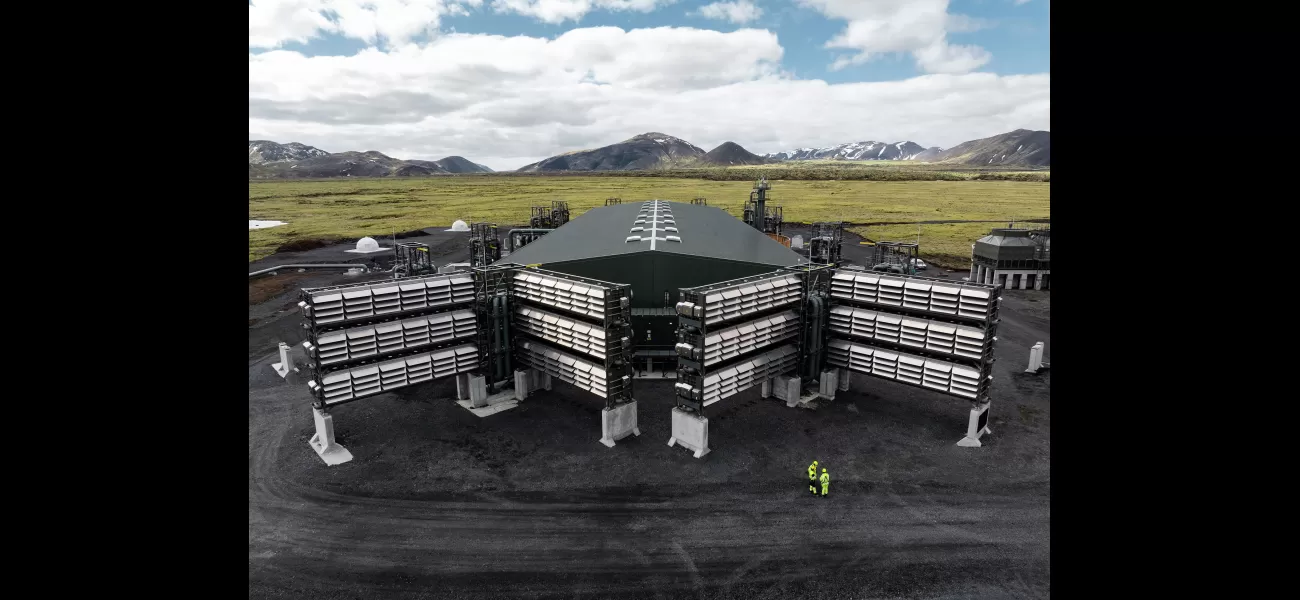How does the world's largest carbon vacuum function?
Scientists say reducing emissions by 7800 cars won't solve climate change and could divert attention from other necessary actions.
May 8th 2024.

A groundbreaking new plant, known as "Mammoth", has recently opened in Iceland, with the impressive goal of removing planet-heating pollution from the atmosphere. The plant, designed by Swiss company Climeworks, is the largest of its kind and utilizes the process of direct air capture, or DAC, to remove carbon from the air using chemicals. This carbon can then be stored deep underground, reused, or even transformed into solid products.
Climeworks has partnered with Icelandic company Carbfix to transport the captured carbon underground, where it will naturally transform into stone, permanently locking up the carbon. And the best part? The entire operation is powered by Iceland's abundant and clean geothermal energy.
With the continued burning of fossil fuels, concentrations of carbon dioxide in the atmosphere have reached record highs. This has led to devastating consequences for both humans and nature, making it crucial to find ways to remove carbon from the atmosphere in addition to reducing our reliance on fossil fuels.
However, some are skeptical about carbon removal technologies like DAC, citing concerns over cost, energy usage, and their effectiveness on a large scale. Some also worry that these technologies may divert attention away from the urgent need to cut fossil fuel usage.
Despite these concerns, Climeworks has moved forward with their plans, starting construction on Mammoth in 2022. The plant has a modular design that allows for easy movement and expansion, with space for 72 "collector containers" that capture carbon from the air. At full capacity, Mammoth can remove up to 36,000 tonnes of carbon from the atmosphere, equivalent to taking 7800 cars off the road for a year.
While this is certainly a significant step in the fight against climate change, it is still just a small fraction of what is needed. According to the International Energy Agency, all the carbon removal equipment in the world can only remove about 0.01 million tonnes of carbon per year, far from the 70 million tonnes needed to meet global climate goals by 2030.
Other companies, such as Occidental, have plans for even larger DAC plants, with the capacity to remove 500,000 tonnes of carbon per year. However, there are concerns that this captured carbon may be used for "enhanced oil recovery", a process that allows fossil fuel companies to extract more oil from aging fields. This has raised concerns that carbon removal technologies may ultimately prolong the use of fossil fuels.
But for Climeworks, the potential for their technology is immense, and they have ambitious plans for the future. Co-founder and co-CEO Jan Wurzbacher envisions scaling up their carbon removal to 1 million tonnes per year by 2030 and a staggering 1 billion tonnes by 2050. With potential plans for DAC plants in Kenya and the United States, Climeworks is determined to make a significant impact in the fight against climate change.
Climeworks has partnered with Icelandic company Carbfix to transport the captured carbon underground, where it will naturally transform into stone, permanently locking up the carbon. And the best part? The entire operation is powered by Iceland's abundant and clean geothermal energy.
With the continued burning of fossil fuels, concentrations of carbon dioxide in the atmosphere have reached record highs. This has led to devastating consequences for both humans and nature, making it crucial to find ways to remove carbon from the atmosphere in addition to reducing our reliance on fossil fuels.
However, some are skeptical about carbon removal technologies like DAC, citing concerns over cost, energy usage, and their effectiveness on a large scale. Some also worry that these technologies may divert attention away from the urgent need to cut fossil fuel usage.
Despite these concerns, Climeworks has moved forward with their plans, starting construction on Mammoth in 2022. The plant has a modular design that allows for easy movement and expansion, with space for 72 "collector containers" that capture carbon from the air. At full capacity, Mammoth can remove up to 36,000 tonnes of carbon from the atmosphere, equivalent to taking 7800 cars off the road for a year.
While this is certainly a significant step in the fight against climate change, it is still just a small fraction of what is needed. According to the International Energy Agency, all the carbon removal equipment in the world can only remove about 0.01 million tonnes of carbon per year, far from the 70 million tonnes needed to meet global climate goals by 2030.
Other companies, such as Occidental, have plans for even larger DAC plants, with the capacity to remove 500,000 tonnes of carbon per year. However, there are concerns that this captured carbon may be used for "enhanced oil recovery", a process that allows fossil fuel companies to extract more oil from aging fields. This has raised concerns that carbon removal technologies may ultimately prolong the use of fossil fuels.
But for Climeworks, the potential for their technology is immense, and they have ambitious plans for the future. Co-founder and co-CEO Jan Wurzbacher envisions scaling up their carbon removal to 1 million tonnes per year by 2030 and a staggering 1 billion tonnes by 2050. With potential plans for DAC plants in Kenya and the United States, Climeworks is determined to make a significant impact in the fight against climate change.
[This article has been trending online recently and has been generated with AI. Your feed is customized.]
[Generative AI is experimental.]
0
0
Submit Comment





